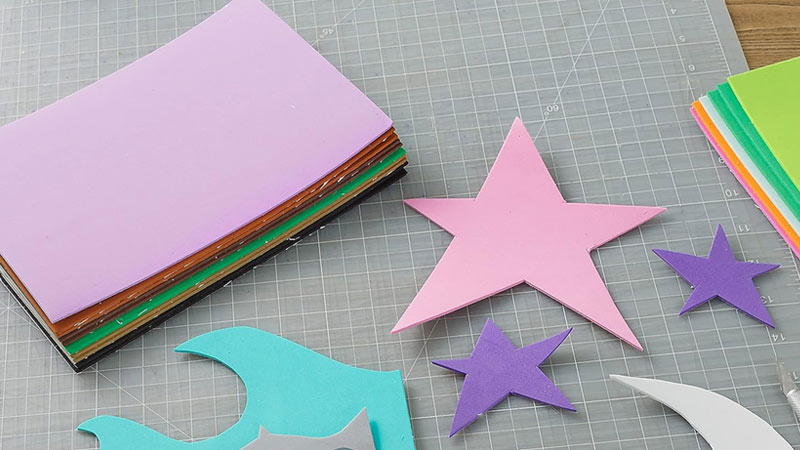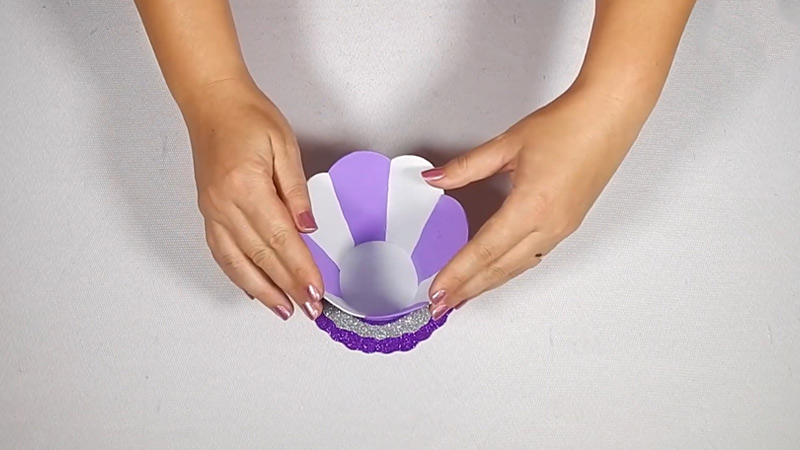Craft foam has become a staple in the realm of DIY projects, cosplay, and artistic endeavors. Its versatility and ease of use make it a favorite material for beginners and seasoned crafters.
But have you ever wondered what lies beneath the colorful surface of this spongy material? What is craft foam made of? In this exploration, we delve into the composition of craft foam, unraveling the mystery behind its unique properties.
Craft foam is a synthetic material that has revolutionized the crafting world, offering a lightweight and pliable alternative to traditional materials.
To understand what craft foam is made of, we journeyed through the manufacturing process, examining the key ingredients and methods that transform raw materials into beloved foam sheets.
From polymers to additives, join us as we uncover the chemistry and craftsmanship behind the creation of this beloved crafting essential.

What Is Craft Foam Made Of?
To truly appreciate its unique properties, it’s essential to understand what craft foam is made of and the intricate processes involved in its manufacturing. Here are the details:
The Foundation: Polymers and Additives
At its core, craft foam is a synthetic material primarily composed of polymers. Polymers are large molecules made up of repeating subunits, forming a structure that provides the foam’s distinctive characteristics.
The most common polymer used in craft foam is polyethylene, a type of plastic known for its flexibility and durability.
Craft foam manufacturers often introduce additives during the production process to enhance specific qualities of the foam. These additives may include colorants, stabilizers, and blowing agents.
Colorants give craft foam its vibrant hues, while stabilizers ensure the material’s longevity and resistance to environmental factors. Blowing agents play a crucial role in creating the characteristic bubbles that give the foam its lightweight and airy texture.
The Manufacturing Process
Craft foam undergoes a complex manufacturing process that transforms raw materials into the sheets or shapes we find at craft stores. The process typically involves the following key steps:
Polymerization
The production of craft foam begins with the polymerization of monomers, which are the building blocks of polymers. In the case of craft foam, polyethylene is often derived from ethylene gas through a polymerization process.
Additive Incorporation
After polymerization, various additives are introduced to the polymer mixture. These additives determine the foam’s color, stability, and texture. The carefully curated combination of additives is crucial in achieving the desired properties of the final product.
Extrusion
Now enriched with additives, the polymer mixture is melted and forced through an extrusion machine. This process shapes the molten material into sheets or other desired forms. The thickness of the sheets can be adjusted based on the intended use of the craft foam.
Foaming
The extruded sheets are then subjected to a foaming process. This involves introducing blowing agents into the material. As the material cools, these agents release gas, creating bubbles throughout the foam.
The density and size of these bubbles contribute to the foam’s texture and lightweight nature.
Cooling and Cutting
Once the foaming process is complete, the material is cooled and solidified. The now-expanded foam is then cut into sheets or shapes, ready to be packaged and sent to crafters worldwide.
The Versatility of Craft Foam
Craft foam’s unique composition and manufacturing process contribute to its versatility, making it suitable for various artistic applications.
The lightweight and pliable nature of the foam allows for easy cutting, shaping, and manipulation, making it ideal for projects ranging from simple crafts to intricate cosplay creations.
Crafting and DIY Projects

Craft foam sheets are a staple for various crafting projects. From handmade cards to decorative ornaments, the foam’s vibrant colors and ease of use make it a favorite among DIY enthusiasts.
Cosplay Creations
Craft foam’s flexibility and ability to mimic more expensive materials make it a popular choice in cosplay. It can be easily shaped into armor, weapons, and intricate costume details, providing a cost-effective alternative for cosplayers.
Educational Activities
Its lightweight and safe properties also make craft foam a go-to material for educational activities. Teachers often use it for art projects that engage students’ creativity while ensuring a safe and enjoyable crafting experience.
Home Décor
Craft foam’s versatility extends to home décor projects. From customizing picture frames to creating personalized wall art, the foam’s adaptability allows for endless possibilities in sprucing up living spaces.
Environmental Considerations
While craft foam offers many creative possibilities, it’s important to consider its environmental impact. Being a synthetic material, craft foam is not biodegradable, and its production involves using petroleum-based resources.
As awareness of environmental issues grows, there has been a shift towards more sustainable crafting materials.
Crafters are encouraged to explore eco-friendly alternatives or engage in responsible disposal practices to minimize the environmental footprint of craft foam.
What Are the Types of Foam for Crafting?
Crafting with foam opens up a world of possibilities, and various types of foam are available to cater to different project needs.
Each type of foam has unique properties that make it suitable for specific applications. Here, we explore some common types of foam used in crafting:
Craft Foam Sheets

Craft foam sheets are perhaps the most versatile and widely used type of foam in crafting. Made from materials like polyethylene, these sheets come in various colors and thicknesses.
They are easy to cut, shape, and glue, making them ideal for various projects such as scrapbooking, card making, and creating decorative elements.
Foam craft sheets are also popular for educational activities because they are lightweight and safe.
EVA Foam
Ethylene-vinyl acetate (EVA) foam is a type of closed-cell foam known for its durability and flexibility. It is commonly used in crafting, particularly in projects that require a more rigid and durable material.
EVA foam is frequently chosen for cosplay creations, costume armor, and props due to its ability to hold intricate shapes and withstand wear and tear. It is available in various thicknesses and can be easily cut, heart-shaped, and glued.
Foam Balls and Shapes
Spherical foam balls and pre-cut foam shapes are popular for various craft projects. These foam elements are commonly used in creating ornaments, floral arrangements, and school projects.
The lightweight nature of foam balls allows for easy manipulation and decorating, making them a favorite for three-dimensional crafts and DIY home decor.
Styrofoam
Expanded polystyrene foam, commonly known as Styrofoam, is a lightweight and rigid foam often used as a base for crafting projects.
It is easily cut and shaped with a knife or hot wire cutter, making it suitable for creating prototypes, model building, and various decorative elements.
Styrofoam is available in different densities, providing options for projects that require both sturdiness and a delicate touch.
Adhesive-Backed Foam
Adhesive-backed foam sheets are convenient for quick and mess-free crafting. These sheets come with a peel-and-stick backing, eliminating the need for additional glues or adhesives.
They are commonly used for adding dimension to projects, such as creating layers or foam stickers for embellishments. Adhesive-backed foam is popular in scrapbooking and card making due to its ease of use in foam sheet craft.
Memory Foam
Memory foam, known for its ability to conform to pressure and return to its original shape, has found its way into crafting.
Crafters use memory crafting foam for projects that require a softer and more cushioned feel, such as making seat cushions, pillows, or plush toys.
Its unique properties make it an interesting option for adding comfort and texture to various craft creations.
Foam Clay
Foam clay is a pliable, lightweight modeling material that air-dries to a soft, foam-like texture. It is a favorite among crafters for creating sculptures, figurines, and detailed embellishments. Foam clay is easy to mold, making it suitable for both adults and children.
Once dry, it retains a lightweight and slightly spongy quality, allowing for versatile use in craft projects.
High-Density Foam
High-density foam is a more robust and firm type of foam used in craft foam sheets, particularly for projects that require structural support. It is often employed in model building, architectural design, and creating dioramas.
High-density foam can be carved, sanded, and painted to achieve intricate details, making it a favorite for more advanced crafting projects.
FAQs
Is craft foam the same as styrofoam?
Craft foam and Styrofoam are terms often used interchangeably but refer to different materials with distinct properties. Understanding craft foam and Styrofoam differences is crucial for choosing the right material for your crafting projects.
Can craft foam be recycled?
Recycling craft foam can be challenging due to its synthetic nature. However, some recycling facilities may accept certain types of foam. It’s advisable to check with local recycling centers to determine their policies on accepting craft foam.
What are some tips for working with craft foam?
Working with craft foam can be a delightful experience with a few tips in mind. Use sharp, fine-edged scissors or craft knives for precise cuts, and consider using a hot glue gun for secure adhesion.
Can craft foam be used for outdoor projects?
While craft foam is not inherently weather-resistant, there are ways to make it more suitable for outdoor use. Applying a waterproof sealant or outdoor-friendly paint can help protect craft foam from the elements.
How do I clean and maintain craft foam creations?
Cleaning craft foam creations depends on the project and the type of dirt or stains involved. In general, mild soap and water can be used for surface cleaning. Avoid using harsh chemicals that may degrade the foam.
Conclusion
The crafting world has been forever changed by the advent of craft foam, a material that bridges the gap between creativity and accessibility.
As we’ve explored, craft foam primarily comprises synthetic polymers carefully engineered to provide a perfect balance of flexibility and resilience. Its widespread use in various artistic pursuits, from cosplay to home décor, highlights its adaptability and popularity.
As we wrap up our journey into the composition of craft foam, it’s clear that this seemingly simple material results from intricate manufacturing processes and the ingenuity of material science.
Its lightweight nature and a rainbow of colors and textures open up a world of possibilities for creators.
Leave a Reply